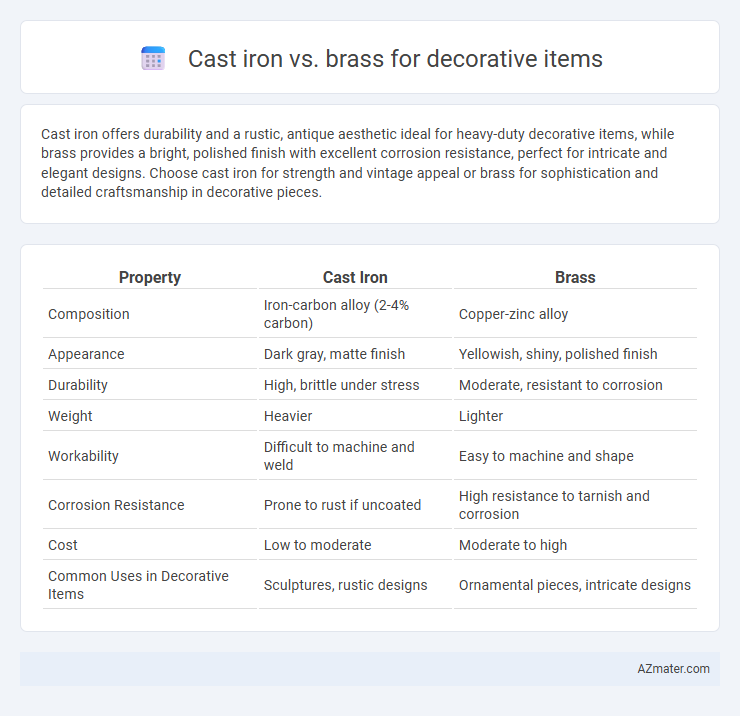Cast iron offers durability and a rustic, antique aesthetic ideal for heavy-duty decorative items, while brass provides a bright, polished finish with excellent corrosion resistance, perfect for intricate and elegant designs. Choose cast iron for strength and vintage appeal or brass for sophistication and detailed craftsmanship in decorative pieces.
Table of Comparison
| Property | Cast Iron | Brass |
|---|---|---|
| Composition | Iron-carbon alloy (2-4% carbon) | Copper-zinc alloy |
| Appearance | Dark gray, matte finish | Yellowish, shiny, polished finish |
| Durability | High, brittle under stress | Moderate, resistant to corrosion |
| Weight | Heavier | Lighter |
| Workability | Difficult to machine and weld | Easy to machine and shape |
| Corrosion Resistance | Prone to rust if uncoated | High resistance to tarnish and corrosion |
| Cost | Low to moderate | Moderate to high |
| Common Uses in Decorative Items | Sculptures, rustic designs | Ornamental pieces, intricate designs |
Introduction to Cast Iron and Brass in Decorative Items
Cast iron offers durability and a rustic appeal often favored in decorative items like garden furniture and vintage-style accents. Brass provides a warm, golden luster that enhances intricate designs and ornamental details, commonly used in chandeliers, statues, and hardware. Choosing between cast iron and brass depends on the desired aesthetic, weight considerations, and resistance to corrosion in decorative applications.
Material Composition and Properties Comparison
Cast iron, composed primarily of iron with 2-4% carbon, offers high durability and excellent wear resistance, making it ideal for sturdy decorative items with a rustic appeal. Brass, an alloy of copper and zinc, provides superior corrosion resistance, a bright gold-like finish, and easy machinability, enhancing its suitability for intricate and polished decorative pieces. The choice between cast iron and brass depends on the desired aesthetic, weight tolerance, and environmental exposure of the decorative item.
Visual Aesthetics: Cast Iron vs Brass Appeal
Brass offers a warm, golden luster that enhances the visual appeal of decorative items with its bright and reflective surface, creating an elegant and luxurious aesthetic. Cast iron provides a more rustic, matte finish, often featuring intricate detailing that contributes to a vintage or industrial style. The choice between brass and cast iron depends on whether the desired look is polished sophistication or rugged, textured charm.
Durability and Longevity of Decorative Pieces
Cast iron offers exceptional durability due to its high resistance to wear, corrosion, and impact, making decorative items long-lasting even in outdoor environments. Brass provides moderate durability with good resistance to corrosion and tarnishing, but it is softer and more prone to dents and scratches compared to cast iron. For longevity, cast iron decorative pieces often require less maintenance and retain structural integrity longer, whereas brass pieces benefit from periodic polishing to maintain their aesthetic appeal.
Maintenance Requirements for Both Materials
Cast iron requires regular protection from moisture to prevent rust, making periodic cleaning and application of anti-rust coatings essential for maintaining its decorative appeal. Brass, on the other hand, demands frequent polishing to avoid tarnish and maintain its bright, golden finish, but it is less vulnerable to corrosion than cast iron. Both materials benefit from gentle cleaning with non-abrasive products, yet cast iron's maintenance is more labor-intensive due to its susceptibility to oxidation.
Corrosion Resistance and Weather Tolerance
Cast iron offers moderate corrosion resistance but is prone to rust when exposed to moisture, making it less suitable for outdoor decorative items unless properly coated. Brass exhibits superior corrosion resistance due to its copper and zinc alloy composition, allowing it to withstand humidity and weather variations with minimal tarnishing. For long-lasting decorative pieces exposed to the elements, brass provides enhanced weather tolerance and maintains its aesthetic appeal better than cast iron.
Weight and Handling Considerations
Cast iron decorative items are significantly heavier than brass, providing a solid, sturdy feel but making them more challenging to move or reposition frequently. Brass, being lighter and more malleable, allows for easier handling and intricate detailing while maintaining durability. Weight considerations impact placement options and user comfort, with cast iron favoring stability and brass enhancing portability.
Cost Analysis: Cast Iron vs Brass
Cast iron offers a more cost-effective option for decorative items due to its lower material and manufacturing expenses compared to brass. Brass, composed primarily of copper and zinc, tends to be pricier because of fluctuating metal markets and its higher alloy value. When considering long-term investment, cast iron provides durability at a budget-friendly price, while brass commands a premium for its aesthetic appeal and corrosion resistance.
Common Uses in Home and Garden Decor
Cast iron is commonly used for garden benches, planters, and ornate gates due to its durability and rustic aesthetic, making it ideal for outdoor decor exposed to weather elements. Brass, favored for its elegant finish and resistance to corrosion, is often chosen for indoor items such as lamps, drawer pulls, and decorative sculptures that add a warm, polished look to home interiors. Both materials complement different design styles, with cast iron emphasizing sturdiness and vintage charm, while brass enhances detailed craftsmanship and sophistication in home and garden decor.
Choosing the Best Material for Your Decorative Needs
Cast iron offers durability and a rustic aesthetic, making it ideal for heavy, vintage-style decorative items that require sturdiness and weather resistance. Brass provides a bright, polished look with excellent corrosion resistance, perfect for ornate and intricate designs that demand a touch of elegance and longevity. Selecting between cast iron and brass depends on the desired weight, finish, and environmental exposure of the decorative piece.

Infographic: Cast iron vs Brass for Decorative item
 azmater.com
azmater.com